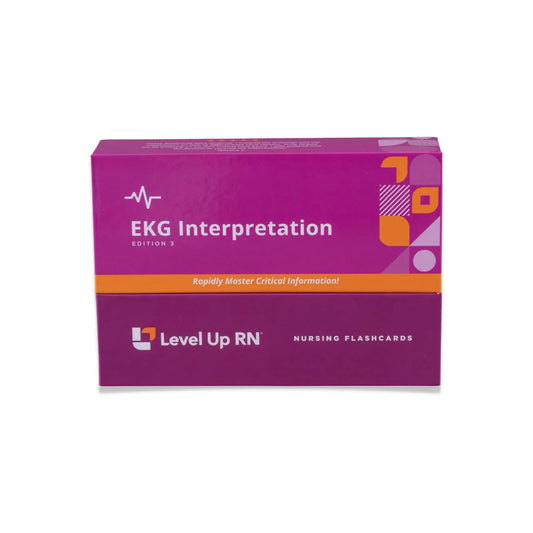In this article, we'll explain everything you need to know about atrioventricular (AV) blocks, including a 1st degree AV block, 2nd degree AV block type 1 (Mobitz I or Wenckebach), 2nd degree AV block type 2 (Mobitz II), and the 3rd degree AV block.
As we explained in our article on the steps in the heart conduction, normally the atrium initiates an electrical impulse, which eventually reaches the ventricles. Atrioventricular blocks are a type of heart block that occurs when that impulse is impaired (blocked) in some way.
The EKG interpretation video series follows along with our EKG interpretation flashcards, which are intended to help RN and PN nursing students study for nursing school exams, including the ATI, HESI, and NCLEX.

EKG Interpretation - Nursing Flashcards
1st degree AV block
A first degree AV block causes a prolonged impulse conduction time from the atria to the ventricles, due to a delay in the AV node.
Treatment
Treatment of a 1st degree AV block is usually not necessary, however, it's important to monitor the patient's rhythm to make sure it doesn't progress into a more severe block.
EKG Analysis
On the strip above, you can see that the rhythm is regular. There is an equal distance between R waves, which mean the ventricular rhythm is regular, and an equal distance between P waves, which means the atrial rhythm is regular.
Heart rate
In the EKG strip shown above, there are approximately 25 small boxes between the R waves. 1500 divided by 25 is 60, so the heart rate is about 60 beats per minute
Components
In the EKG strip shown above, the P wave is upright as expected, and has the normal duration of .12-.20 seconds long and amplitude of 2.5mm high. However, we can see that the PR interval is prolonged. It is approximately 8 small boxes in duration, or approximately .32 seconds, which is longer than the expected duration of .20 seconds. The prolonged PR interval is the key indicator of a 1st degree AV block.
Tip to remember
There is a cute poem that might help you remember that a prolonged PR interval is the key indicator of a 1st degree AV block. The poem is: "If the R is far from P, then you have a first degree."
Another story that might help you remember is to think of a dysfunctional couple living together. The sensible partner is the P wave, the wayward partner is the QRS complex (R). With a first degree AV block, R comes home late every night. R always comes home, but they come home late.

2nd degree AV block type 1 (Mobitz I, Wenckebach)
A second degree AV block type 1, which is also known as Mobitz I or Wenckebach, causes a progressive increase in the impulse conduction times between the atria and ventricles until one impulse fails to conduct.
Treatment
Usually, second degree AV blocks type 1 are temporary and do not require treatment. However, if the patient's cardiac output is insufficient, then the antiarrhythmic atropine can be used for patients with this type of block.
Atropine is a key cardiac med you will need to know in your pharmacology studies and is one of the important meds covered in our Pharmacology flashcards for nursing students.
EKG Components
In the strip shown above, the distance between P waves is consistent, which means that the atrial heart rhythm is regular. However, because there are some missing QRS complexes, there is not a consistent amount of space between R waves, which means that the ventricular heart rhythm is irregular.
The P waves are upright and the expected duration and amplitude. However, the PR intervals in the strip shown above get progressively longer and longer.
Tip to remember
To remember 2nd degree AV block type 1 (also known as Mobitz I or Wenckebach) you can remember a cute poem or the story of the dysfunctional couple.
The cute poem is, "Longer, longer, longer, drop. Then you have Wenckebach."
In the story of the dysfunctional couple, remember that the P wave is the sensible spouse while the QRS complex (R) is the wayward one. In a 2nd degree AV block type I, The P wave stays at home, while the QRS complex is staying out later, and later, and later, each night. Until one night, the QRS complex does not come home at all.

2nd degree AV block type 2 (Mobitz II)
A 2nd degree AV block type 2 is also known as Mobitz II, and this type of block causes a sudden failure of impulse conduction from the atria to the ventricles, without a progressive increase in conduction time. This is the difference between a 2nd degree AV block type 1 and 2nd degree AV block type 2; type 1 has a progressive increase in conduction time, while type 2 does not.
Treatment
A 2nd degree AV block type 2 is usually permanent and a patient will require treatment with an artificial pacemaker.
EKG Components
In the 2nd degree AV block type 2 EKG strip shown above, you can see there is an equal distance between P waves, so we can confirm the atrial rhythm is regular. However, there are missing QRS complexes, which means there is not an equal distance between R waves, and so the ventricular heart rhythm is irregular.
The P waves in 2nd degree AV block type 2 are upright, and the expected duration and amplitude. The PR intervals are also consistent; though they may be normal duration or they may be long, the key indicator that this is a 2nd degree AV block type 2 and not a type is that the PR intervals are consistent.
Another key indicator is that the QRS complexes are missing.
Tips to remember
To remember 2nd degree AV block type 2 (also known as Mobitz II) you can remember a cute poem or the story of the dysfunctional couple.
The cute poem is, "if some Ps don't get through, then you have a Mobitz II."
In the story of the dysfunctional couple, remember that the P wave is the sensible spouse while the QRS complex (R) is the wayward one. In a 2nd degree AV block type II, the P wave stays at home, while the QRS complex comes home at consistently the same time—except one day QRS randomly does not come home!

3rd degree AV block
A 3rd degree AV block causes a complete failure in all impulse conduction from the atria to the ventricles.
Treatment
A patient with a 3rd degree AV block will require an artificial pacemaker.
EKG components
In the 3rd degree AV block EKG strip shown above, there are equal distances between the R waves, so we know that the ventricular heart rhythm is regular. The P waves are also consistent distances apart, so we know that the atrial heart rhythm is also regular.
The key indicator that this is a 3rd degree AV block EKG strip is that the P waves are not associated with the QRS complexes. If you recall from our article on EKG Basics, a normal EKG is supposed to show a P wave, followed by a QRS complex, followed by a T wave.
But in the case of a 3rd degree AV block, the P waves are completely independent of the QRS complex. There is no impulse conduction between the atria and the ventricles, so these components are not following their expected, interconnected pattern. You can also discern that they are not connected because there are more P waves than QRS complexes.
Tip for remembering
To remember 3rd degree AV block, you can remember a cute poem or the story of the dysfunctional couple.
The poem is: "If R and P don't agree, then you have a third degree!"
The story of the dysfunctional couple is as follows. The P wave and QRS complex live in the same home, but they are not connected. The P wave comes and goes as they please, and the QRS complex comes and goes as they please. They do not communicate, and have basically no relationship!



9 comments
Very very helpful thanks god bless you ❤️
This is very helpful. Easy to understand!
Dear Cathy, thank you very much. Makes it much simpler to remember then a whole bunch of words! Very much appreciated!
Educative